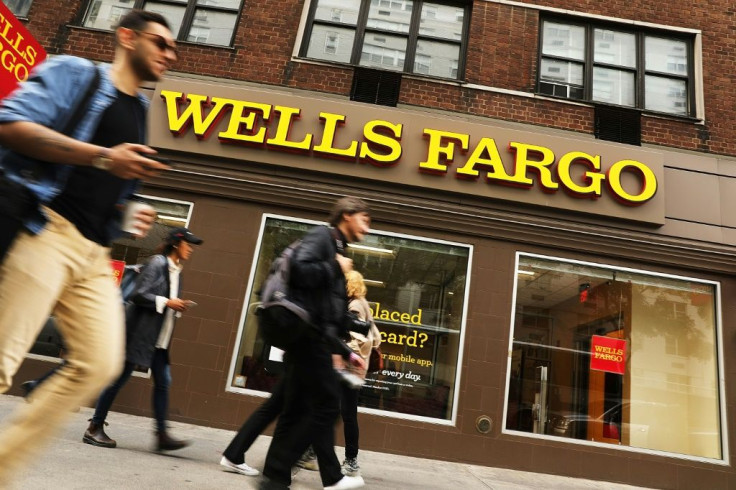Coronavirus Impact: Wells Fargo, JPMorgan Earnings Plunge As They Set Aside Huge Loan Loss Provisions

KEY POINTS
- Wells Fargo posted first quarter earnings of only $0.01 per share
- Wells Fargo set aside $4 billion in loan-loss provisions in the first quarter
- JPMorgan said its first-quarter profit plunged by 69%
Banking behemoths Wells Fargo & Co. (WFC) and JPMorgan Chase & Co. (JPM) set aside huge reserves in the first quarter in anticipation of a spike in loan defaults by consumers and businesses during the nationwide shutdown amid the coronavirus pandemic.
Wells Fargo posted first quarter earnings of only $0.01 per share – far below analyst expectations of $0.33 per share – as it set aside reserves for anticipated credit losses arising from the coronavirus pandemic. (Wells Fargo reported earnings of $1.20 per share in the first quarter of 2019).
Wells Fargo set aside $4 billion in loan-loss provisions in the first quarter, nearly five times its allocation from one year ago and the largest such amount in a decade.
The banking giant’s net income plunged 89% to $653 million for the quarter, while first quarter revenues of $17.7 billion fell well below expectations of $19.3 billion.
“Our results… reflected the expected impact these unprecedented times could have on our customers,” Chief Financial Officer John Shrewsberry said in a statement.
As a major lender to consumers, small businesses, and commercial property investors across the country, Wells Fargo’s financial performance reflect the health of a broad swath of the U.S. economy.
“Wells Fargo plays an important role in the financial system and the economic strength of our country, and we take our responsibility seriously, particularly in these unprecedented times,” stated CEO Charles Scharf on Tuesday.
Scharf noted that the bank’s commercial clients used more than $80 billion of their loan commitments in the month of March alone. Provisions in the bank’s wholesale unit skyrocketed by a factor of 17 from a year ago.
Wells Fargo is participating in the federal government’s Paycheck Protection Program, which allocates $349 billion in forgivable loans to small businesses as a stimulus measure. However, Wells Fargo’s participation was capped at $10 billion in loans due to regulatory limitations arising from prior scandals at the bank (although Wells Fargo received a temporary reprieve from that restraint last week in order to loan to small businesses).
Wells Fargo has also vowed to take a number of steps to help its customers and employees, including offering grace periods to mortgage borrowers and pausing planned job cuts.
Meanwhile, JPMorgan said its first-quarter profit plunged by 69% -- to their lowest levels in more than six years -- as credit costs mounted. JPMorgan set aside $8.29 billion for bad loans, the largest provision in a decade.
JPMorgan also boosted its loan-loss reserve by more than $11 billion as it prepares for higher defaults on its credit cards.
Chief Executive Officer Jamie Dimon had earlier warned investors to brace for the impact of the pandemic, even citing the crisis would lead to a “bad recession.”
On Tuesday, Dimon reiterated those sentiments. “Given the likelihood of a fairly severe recession, it was necessary to build credit reserves,” he said. “The first quarter delivered some unprecedented challenges and required us to focus on what we as a bank could do -- outside of our ordinary course of business -- to remain strong, resilient and well-positioned to support all of our stakeholders.”
However, JPMorgan was able to offset some of its losses by robust performance in its trading operations, which benefitted from extreme market volatility. JPMorgan generated an all-time record $7.23 billion from trading stocks and bonds.
As with other major banks, JPMorgan has offered some relief to customers – it has waived fees for some loans, allowed customers to defer payments on mortgages and auto loans, and removed minimum payment requirements on credit cards.
However, first quarter banking results only included one month (March) where the pandemic wreaked havoc on small businesses and employment, suggesting banks will incur even worse results in the coming quarter.
Meanwhile, even with a temporary removal on its loan cap, Wells Fargo is again telling customers to seek emergency loans elsewhere as it deals with a huge backlog of applications.
“While you remain in queue based upon when you submitted your initial interest, due to high demand we are not able to begin your application at this time,” Wells Fargo said in an email to customers. “You remain in our queue. However, since there is a limited amount of funds approved by the [Small Business Administration] for the Paycheck Protection Program, we want you to be aware of your options. You may want to apply elsewhere to increase your chances of receiving a loan before the funds run out.”
© Copyright IBTimes 2025. All rights reserved.





















